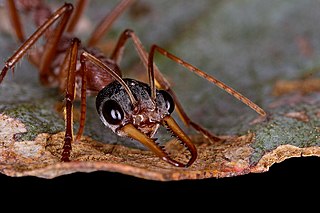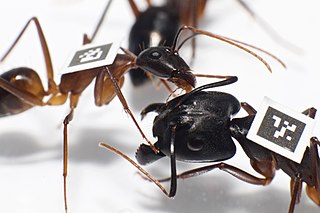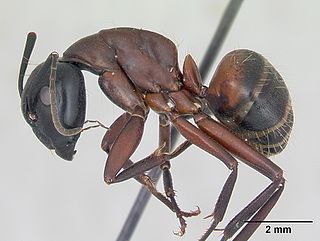
Ants are eusocial insects of the family Formicidae and, along with the related wasps and bees, belong to the order Hymenoptera. Ants evolved from vespoid wasp ancestors in the Cretaceous period. More than 13,800 of an estimated total of 22,000 species have been classified. They are easily identified by their geniculate (elbowed) antennae and the distinctive node-like structure that forms their slender waists.

Trophallaxis is the transfer of food or other fluids among members of a community through mouth-to-mouth (stomodeal) or anus-to-mouth (proctodeal) feeding. Along with nutrients, trophallaxis can involve the transfer of molecules such as pheromones, organisms such as symbionts, and information to serve as a form of communication. Trophallaxis is used by some birds, gray wolves, vampire bats, and is most highly developed in eusocial insects such as ants, wasps, bees, and termites.

Honeypot ants, also called honey ants, are ants which have specialized workers that consume large amounts of food to the point that their abdomens swell enormously. Other ants then extract nourishment from them, through the process of trophallaxis. They function as living larders. Honeypot ants belong to any of several genera, including Myrmecocystus and Camponotus. They were first documented in 1881 by Henry C. McCook, and described further in 1908 by William Morton Wheeler.

Formica rufa, also known as the red wood ant, southern wood ant, or horse ant, is a boreal member of the Formica rufa group of ants, and is the type species for that group, being described already by Linnaeus. It is native to Eurasia, with a recorded distribution stretching from the middle of Scandinavia to the northern Iberia and Anatolia, and from Great Britain to Lake Baikal, with unconfirmed reportings of it also to the Russian Far East. There are claims that it can be found in North America, but this is not confirmed in specialised literature, and no recent publication where North American wood ants are listed mentions it as present, while records from North America are all listed as dubious or unconfirmed in a record compilation. The workers' heads and thoraces are colored red and the abdomen brownish-black, usually with dark patches on the head and promensonotum, although some individuals may be more uniform reddish and even have some red on the part of the gaster facing the body. In order to separate them from closely related species, specimens needs to be inspected under magnification, where difference in hairiness are among the telling characteristics, with Formica rufa being hairier than per example Formica polyctena but less hairy than Formica lugubris. Workers are polymorphic, measuring 4.5–9 mm in length. They have large mandibles, and like many other ant species, they are able to spray formic acid from their abdomens as a defence. Formic acid was first extracted in 1671 by the English naturalist John Ray by distilling a large number of crushed ants of this species. Adult wood ants primarily feed on honeydew from aphids. Some groups form large networks of connected nests with multiple queen colonies, while others have single-queen colonies.

Carpenter ants are large ants indigenous to many forested parts of the world.

The name army ant (or legionary ant or marabunta) is applied to over 200 ant species in different lineages. Because of their aggressive predatory foraging groups, known as "raids", a huge number of ants forage simultaneously over a limited area.

Tapinoma sessile is a species of small ant that goes by the common names odorous house ant, sugar ant, stink ant, and coconut ant. Their colonies are polydomous and polygynous. Like many social insects, T. sessile employs complex foraging strategies, allocates food depending on environmental conditions, and engages in competition with other insects.

The banded sugar ant, also known as the sugar ant, is a species of ant native to Australia. A member of the genus Camponotus in the subfamily Formicinae, it was described by German entomologist Wilhelm Ferdinand Erichson in 1842. Its common name refers to the ant's liking for sugar and sweet food, as well as the distinctive orange-brown band that wraps around its gaster.

Nothomyrmecia, also known as the dinosaur ant or dawn ant, is an extremely rare genus of ants consisting of a single species, Nothomyrmecia macrops. These ants live in South Australia, nesting in old-growth mallee woodland and Eucalyptus woodland. The full distribution of Nothomyrmecia has never been assessed, and it is unknown how widespread the species truly is; its potential range may be wider if it does favour old-growth mallee woodland. Possible threats to its survival include habitat destruction and climate change. Nothomyrmecia is most active when it is cold because workers encounter fewer competitors and predators such as Camponotus and Iridomyrmex, and it also increases hunting success. Thus, the increase of temperature may prevent them from foraging and very few areas would be suitable for the ant to live in. As a result, the IUCN lists the ant as Critically Endangered.

The meat ant, also known as the gravel ant or southern meat ant, is a species of ant endemic to Australia. A member of the genus Iridomyrmex in the subfamily Dolichoderinae, it was described by British entomologist Frederick Smith in 1858. The meat ant is associated with many common names due to its appearance, nest-building behaviour and abundance, of which its specific name, purpureus, refers to its coloured appearance. It is among the best-known species of ant found throughout Australia; it occurs in almost all states and territories except for Tasmania. Its enormous distribution, aggression and ecological importance have made this ant a dominant species.

Camponotus vagus is a species of large, black, Palaearctic carpenter ant with a wide range that includes much of Europe, a large area of Asia, and part of Africa.

Myrmecia nigriceps, also known as the black-headed bull ant, is a species of ant endemic to Australia. A member of the genus Myrmecia in the subfamily Myrmeciinae, it was first described by Austrian entomologist Gustav Mayr in 1862. These ants are large, varying from 19 to 23 millimetres in length. However, colonies contain workers that are much smaller, usually half the size of normal workers. The queens are the largest while the males are the smallest, which can be easily identified due to their small mandibles.

Crematogaster carinata is a species of ant in the tribe Crematogastrini. It was first described by Gustav Mayr in 1862. It is native to Central and South America, where it is a common species, forming large colonies in the canopy of the forest.

Camponotus herculeanus is a species of ant in the genus Camponotus, the carpenter ants, occurring in Northern Eurasia, from Norway to Eastern Siberia, and North America. First described as Formica herculeana by Linnaeus in 1758, the species was moved to Camponotus by Mayr in 1861.

Camponotus floridanus, or Florida carpenter ant, is a species of ant in the genus Camponotus. First described as Formica floridana by Buckley in 1866, the species was moved to Camponotus by Mayr in 1886. The ant is widespread in Florida and occurs as far north as North Carolina and as far west as Mississippi.

Camponotus socius, the sandhill carpenter ant, is a large species of ant in the genus Camponotus. It was first described by Julius Roger (1863), based on specimens from Brazil - however these can be considered highly dubious as the location where the type specimens were collected (Amazonas) does not fit the known ecology of the species within North America, where it exhibits traits typical of a native species. It is well adapted to the sandy soils of xeric woodlands found within the coastal plains of the southeastern United States. Its range includes the US states of Georgia, Alabama, Florida, North and South Carolina and Mississippi.

The black-headed sugar ant, also known as the brown sugar ant, is a species of Formicinae ant endemic to Australia. Found throughout most states, the species is a member of the genus Camponotus, a cosmopolitan genus of ants commonly known as carpenter ants. It was formally described and named by British entomologist Frederick Smith in 1858. These ants are characterised by their black head, reddish-brown mesosoma and black gaster, which can change in colour.

Camponotus castaneus, the red hazelnut carpenter ant, is a species of carpenter ant located in the eastern United States. It is a primarily orangish-red ant in the family Camponotus. Its workers are usually around 8-10 mm, and queens around 18-20 mm. As with most Camponotus species, C. castaneus has majors and super-majors, usually appearing in the second or third year of the colony's founding, majors are usually 10-14 mm, with super majors being around 13-17 mm. C. castaneus has a generalist diet, feeding on insects and carbohydrates such as honeydew, which is easily accessible. The ant has a smooth thorax and abdomen, with 1 node separating them.

Camponotus fellah is a species of carpenter ant found across the Middle East and North Africa. This species was formally described by Dalla Torre in 1893. A C. fellah queen holds the record for Israeli ant longevity, surviving for 26 years (1983-2009) in a laboratory environment.

Camponotus ligniperda, the brown-black carpenter ant, is a common species of carpenter ant distributed widely throughout Europe. Found in a variety of woodland habitats, they commonly nest on the ground in dry tree stumps, dead fallen trees, or beneath stones and wooden logs that are partially buried. C. ligniperda is an ecologically dominant species wherever it is found due to both its large size and particularly aggressive nature.





















